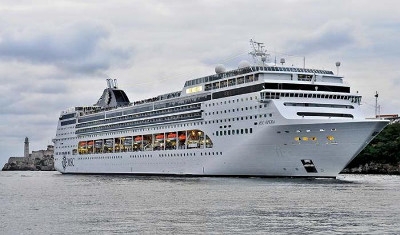A bilateral symposium held in the Cuban capital November 28-29 provided the opportunity to exchange experiences and evaluate the development of the cruise industry in Cuba
Authors: Iramsy Peraza Forte, granma.cu & Sergio Alejandro Gómez, granma.cu
Of the more than four million tourists who visited Cuba in 2016, 112,000 arrived aboard cruise ships. Thus this modality has shown the most growth in the Caribbean over the last five years.
José Manuel Bisbé, director of Viajes Cuba, reported that there are 68,000 hotel rooms available now in Cuba, with 69% in four or five star facilities, and 140 investment projects underway in the sector. Photo: Isel Quintana
Cruise line executives from the world's most important companies agree on the interest Havana attracts as a port-of-call. A bilateral symposium held in the Cuban capital November 28-29 provided the opportunity to exchange experiences and evaluate the development of the cruise industry in Cuba.
The central topic on the agenda was the tourist boom evident on the island over the last several years, which has favored cruise lines, and the creation of new alliances, paving the way for more business in the future.
Josefina Vidal, director general for the United States at Cuba's Foreign Ministry and one of the participants in the symposium, emphasized on her Twitter account that industry leaders said Cuba has a special identity as a country and that Havana is the number one favorite stop among passengers on Norwegian Cruise Line, one of the U.S. companies operating here.
"Cruise ship passengers love to come to Cuba, experience its natural beauty, security, and the warm, welcoming, attractive nature of its people," Vidal commented. During the last working session, José Manuel Bisbé, director of the Viajes Cuba Enterprise Group, discussed with his counterparts the potential for the cruise industry's development in Cuba.
He recalled that some 4.2 million international visitors had arrived in Cuba this year through November 26, indicating that more than the projected 4.7 million could be expected by the end of 2017. This data makes clear the importance of tourism to the country's economy, as one of the most dynamic sectors, thus confirming the potential for collaboration, he said. Bisbé outlined Cuba's attractions as a popular tourist destination, highly regarded among Caribbean islands and locations worldwide, not only for its natural beauty, but for the cordial hospitality of Cubans.
He discussed plans to expand port infrastructure with a view toward receiving a greater number of cruise ships in the future, and progress made in recovery efforts following damage caused by Hurricane Irma to tourist facilities.
Attending the meeting - sponsored by the Cruise Lines International Association, the Florida-Caribbean Cruise Association, and the travel agency Havanatur - were American Cruise Lines, Virgin Voyages, Holland America Line, MSC Cruises, Club Cruises, Silversea Cruises, Celestyal Cruises, Disney Cruise Line, Carnival Cruise Line, Royal Caribbean Cruise Line, Norwegian Cruise Line Holdings Ltd, and Pearl Seas Cruises, these last four from the United States. All operate successfully in Cuba, according to reports on other occasions.
Since the reestablishment of diplomatic relations between the U.S. and Cuba, arrivals of visitors from that country have increased dramatically, given the decision by President Obama to make the travel license process for U.S. citizens more flexible.
Although blockade-related laws still prohibit travel to Cuba for the purpose of tourism, the increase in visits continues. In the first half of 2017, the number of visitors from the U.S. was equal to the previous year's total.
Since the beginning of the thaw in relations, Cuba has signed memoranda of understanding with port authorities in the states of Virginia; Louisiana (Lake Charles, New Orleans); Alabama; Mississippi (Pascagoula) and the cites of Houston and Cleveland, which will be key to facilitating expansion of the cruise industry.
However, the new measures adopted by President Donald Trump, described in the meeting as an enormous step back in bilateral relations, not only limit visits to the island by U.S. citizens, but also infringe on the rights of U.S. companies to do business here.
One of the steps taken by the White House was to prohibit commercial relations with a group of Cuban state enterprises, the majority in the tourist sector.
GROWING INVESTMENT IN THE LEISURE INDUSTRY
Speaking with Prensa Latina, José Manuel Bisbé, Viajes Cuba executive, recalled that 25 years ago there were 18,000 hotel rooms in Cuba, while the total has now reached 68,000, with 69% in four or five star facilities, and more than 140 investment projects underway in the sector. He indicated that included in the projects are renovations of existing hotels, and the development of gold club resorts, as well as new facilities, encouraged by incentives established in the country's new foreign investment law. The executive reported that 20 international chains operate in Cuba, in 88 hotels, almost 65% of the total. Likewise, 27 joint ventures are responsible for 4,500 rooms in four and five star facilities.
Bisbé recalled that Hurricane Irma's impact was felt, in one way or another, across the entire island, but that following a tremendous effort, all hotel facilities are now operating. Plans for 2016-2030 project reaching 103,000 rooms; 23 marinas and nautical facilities; 24 linked to golf courses; and 47 recreational/adventure sites.
As examples he mentioned the Ramón Peninsula in the eastern province of Holguín, with plans for 19,159 rooms. He likewise noted Sabinal's 12,785 new rooms, and projects on Paredón Grande and Las Brujas Keys, the latter in the island's central region where 2,895 rooms are projected, and where Cuba's International Tourism Fair (FITCuba 2018) will take place this coming May.

